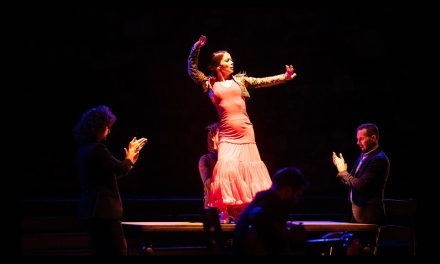I know very little about butoh, but in the last few years I’ve become quite the fan; when performed, the evasive Japanese form implies such rigor that you can’t help but gasp.
The dancers possess this otherworldly patience and command of every muscle—no, every molecule—in their bodies. It seems they focus on a training of the mind simultaneous to the training of the body, rather than allowing brain development to come about as a side effect of movement. Butoh holds movement and the body in such high regard; it is practiced with a reverence that says that movement has the power to enlighten. This regard is, in my opinion, exemplary; we should see and revere more movement this way, with a respect and awe. We should allow it to teach us about our bodies.
Friday night, less than twenty audience members sat themselves in the Electric Lodge in Venice for a performance by Andrés Corchero and Oguri. Corchero would present a new solo, PADRE, and he and Oguri would come together for a duet, 451 – Homage to Ray Bradbury; all as part of the seventeenth annual Flower of the Season, presented by Body Weather Laboratory. Oguri’s legacy alone considered (he came to butoh via a meeting with creator Tatsumi Hijikata), twenty audience members seemed slim—even the small venue could hold more. But he, Corchero, and Body Weather Artistic Director Roxane Steinberg didn’t seem to mind. They received each guest with kind and welcoming words, holding the curtain until each expected guest (even Steinberg’s parents) was comfortably seated.
Corchero’s PADRE was quirky, eclectic, and virtuosic at the same time. The work explored the paternal role, generational gaps and stages of life via his relationship with his father. In portraits that faded in and out, he portrayed many aspects of a masculine connection, telling the story of his own father’s passing and the story of that relationship rekindled and rearranged with his own son. Corchero clearly exhibited the patience of a butoh practitioner, with slow movements and repetitive movements drawn out so far past the point of hypnotism that they became interesting again. He also gave off a sense of wisened comfort with his own bodily instrument, moving in idiosyncratic patterns and letting go of control in ways that allowed him to show carefree human nature. It was movement so controlled it was awe-inspiring, and then movement so deeply relatable that it became innate within the audience’s body: the foreign and the familiar coupled to share a story with such poignance.
Corchero’s daughter, Rita Corchero Pérez, accompanied a section of the piece with a stunning cover of Across the Universe—at fifteen, she spoke text as a teenager but sang with the calming maturity of a beloved mother figure. Her relationship to Corchero in the space was simple and circular, but reflected their connection beautifully, her angelic voice resounding intimately in the black box. Family members Ana Pérez and Caterina Pérez acted as composition assistant and costume designer, respectively—a true family affair—and minimal lighting design by Llorenç Parra was subtly graceful, guiding the eye through set designed by Corchero and Miquel Ruiz.
451—Homage to Ray Bradbury was not the first of Oguri’s collaborations with Corchero. The two met in 1986 in Min Tanaka’s Mai-Juku company, then found each other again in 2011 and revived a relationship as creative collaborators. The two danced with a bond that seemed so clearly founded on a shared insatiable curiosity—the work they presented was spontaneous, inquiring.
The two began each with a stack of books on their shoulders, moving backs to the audience so that it appeared they had books for heads: a fascinating image, marked by impressive balance and careful listening to each other’s timing. They left their books and returned to their books, listening to each other all the while. Each fed off the other’s energy to create a partnership so engrossing I swear I didn’t blink for twenty minutes. Their gestures, fueled by a combination of mimicry and invention, built the purest counterpoint, impressive because of its spontaneity and instantly captivating. This was the product of men shaped by the rigorous mind-work of butoh but made playful by curiosity and influenced by the world around them. It was both worldly and specific—tenderly resonant and timelessly relevant.
Live music by Oguri’s son, Zenji Oguri, filled the theater with a soundscape just ambient enough to lead your attention through the progression. At performance’s end, every mesmerized audience member applauded emphatically, but Oguri and Corchero (and their children) deserved a much more resounding applause. Keep your eyes out for the next presentation at the Electric Lodge (where Oguri and Steinberg have been artists-in-residence since the 90s), and make sure to get yourself there. This is thoughtful art that deserves an audience.
Written by Celine Kiner for LA Dance Chronicle, March 9, 2020.
To visit the Body Weather Laboratory, click here.
Featured image: Andrés Corchero and Oguri in 451—Homage to Ray Bradbury – Photo by Carles Decors








